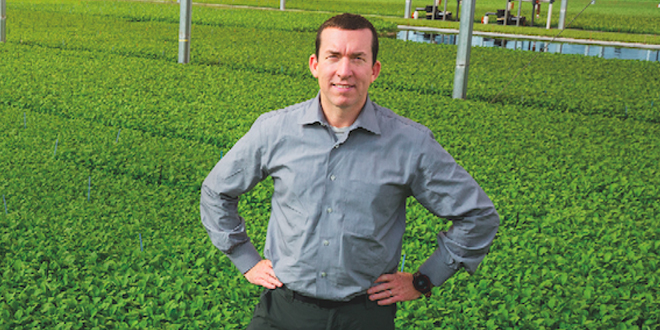Dec 16, 2015BrightFarms: Commercial-scale produce operations in local markets
What is being billed as one of the world’s largest urban farms and greenhouses is nearing completion in Washington, D.C.
The 100,000-square-foot greenhouse is being built by BrightFarms, a company that has also turned supermarket roofs into urban farms. The new greenhouse, in D.C.’s Anacostia neighborhood, will grow about 1 million pounds of produce every year for delivery to 30 local Giant grocery stores, along with neighborhood food banks.
Paul Lightfoot, BrightFarms’ CEO, said the company’s mission is to “improve the environmental impact of the food supply chain and increase the relative consumption of whole and fresh foods. In doing so, it aims to reduce the overall ramifications of produce on the planet and increase the health of our society.”
Lightfoot said BrightFarms makes local food sourcing commercially feasible for supermarkets by financing, building and operating greenhouse farms in partnership with them.
“These partnerships eliminate significant time, distance and costs from the produce supply chain and enable supermarkets to sell produce that is fresh and local,” Lightfoot said. “Traditional U.S. agriculture’s centralized system squanders land, water and fossil fuels, making produce less safe, less tasty and unsustainable for the health of both Americans and the planet.”
Lightfoot said in most parts of the country, fresh produce is highly seasonal, so grocers have few alternatives to buying from the “decentralized mega-farms.”
BrightFarms currently has a 56,000-square-foot greenhouse farm in Yardley, Pennsylvania, that delivers year-round local produce to McCaffrey’s, an independent grocery with stores in Pennsylvania and New Jersey.
BrightFarms is nearing completion with two new greenhouses to serve clients in Washington, D.C., for Ahold USA, and in Chicago for Roundy’s, with plans for many more in the near future.
Bright Farms broke ground in August on a $10 million, 160,000-square-foot hydroponic greenhouse in Rochelle, Illinois. The Chicagoland Greenhouse, near Bay Valley Foods, just off Interstate 88, will grow more than 1 million pounds of salad greens, tomatoes and basil a year for suburban grocer Mariano’s, a division of Milwaukee-based Roundy’s Supermarkets.
Lightfoot said BrightFarms’ produce is significantly more environmentally friendly than produce offered by the traditional long-distance supply chain.
“BrightFarms’ greenhouses use fewer fossil fuels than the traditional long-distance supply chain,” he said. “Our growing method uses far less land and water than the traditional long-distance supply chain. We do not use pesticides and our products are all GMO-free.”
Lightfoot said the average grocery store’s fresh produce travels about 1,500 miles from farm to store, and 95 percent of food in the U.S. travels over 1,000 miles from farm to store.
“Salad greens carried on Midwest and East Coast shelves take up to a week to be transported from the West Coast, decreasing freshness and shelf life while increasing cost,” he said.
BrightFarms currently grows spring mix, baby arugula, baby kale, baby spinach, basil and tomatoes.
Paul Lightfoot said he became involved with the company because “I was yearning to combine my personal passion with my career. I had become increasingly zealous in how I fed myself and my family while in my 30s, and by the time I reached 40 I was ready to bet my career on bringing Americans food that was healthier and better for both them and the planet. Now I’m 45 and thrilled to be delivering on that vision for our supermarket partners’ hundreds of thousands of customers (and my wife and kids) through BrightFarms.
“We intend to focus on successfully ramping up the Chicago and D.C. greenhouses for the first half of 2016, and then will embark on an even more aggressive growth trajectory in the latter part of 2016 and beyond,” Lightfoot said.
“The demand for local food is skyrocketing in the U.S., as people seek fresher food and as they increasingly seek food from sources they trust,” Lightfoot said. “This creates a huge opportunity for a decentralized network of greenhouse farms, and growing hydroponically is perfect for local markets since it is resource efficient and highly productive.”
“My efforts are a small part of a very large and fast growing movement in the U.S.,” he said. “Demand for healthy fresh produce is on the rise, as is demand for locally produced food. I’m proud to help the industry find an innovative way to responsibly produce delicious local produce on a profitable basis.”
He said the Capital Greenhouse project in D.C., once completed, “will be the most productive farm operation in the U.S. that is 100 percent focused on the local food system. All of the baby greens and tomatoes produced will be sold in the metro D.C. area, dramatically reducing the carbon footprint of the food supply chain and reducing the drain on California’s scarce water supply.”
Fast Company recognized BrightFarms as “One of World’s 50 Most Innovative Companies”, and one of the “Top 10 Most Innovative Companies in Food.”
Lightfoot has said when structurally sound rooftops are available and make economic sense – like in the Bronx, where BrightFarms built a 10,000-square foot farm on top of a low-income apartment building – the company builds above ground level. But most cities also have plenty of vacant lots.”















